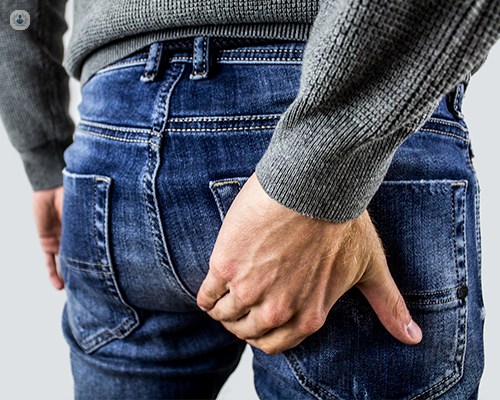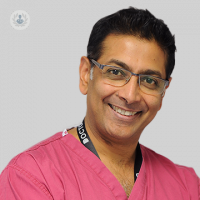Pilonidal sinus: what are the best treatments?
Written by:A pilonidal sinus is a small tunnel that forms in your skin, most commonly at the top of your buttocks. If it becomes infected, it can cause severe pain and inflammation and lead to further problems if left untreated.
Professor Tan Arulampalam is an award-winning consultant general surgeon who specialises in treating pilonidal sinuses. In this article, he discusses the main symptoms, diagnostic procedure and types of treatments available.

What is a pilonidal sinus?
A pilonidal sinus is a small tunnel or tract that forms beneath your skin, at the end of your tailbone - an area known as the natal cleft - where the buttocks separate. A pilonidal sinus doesn’t always cause symptoms, however, if it gets infected it can fill with pus, be very painful and a cyst or abscess can form.
Although less common, a pilonidal sinus can also develop in between your fingers and inside your belly button. In these cases, there may be more than one channel or tract.
What causes a pilonidal sinus?
While the cause of a pilonidal sinus is not known, it is believed that a combination of the following factors plays a role in its development:
- Ingrowing hairs — hair growth or improper hair removal techniques can lead to ingrown hairs, which in turn can irritate the skin and lead to infections.
- Hormones — ingrown hairs along with changing hormones may be one of the causes. Pilonidal sinuses often occur after puberty.
- Friction and infections — sitting for a long time or wearing clothes that rub against the skin can cause friction. This ultimately irritates the skin and results in inflammation which can lead to bacterial infections and contribute to the pilonidal sinus.
Who does pilonidal sinus predominately affect?
Pilonidal sinus is typically more commonly in young adults. It is seen more often in men as they have more body hair than women.
Additionally, having a sedentary job where you sit a lot, being overweight, having a deep hairy natal cleft (the deep groove which runs between the two buttocks) or a family history of the condition may make you more prone to developing pilonidal sinus.
What are the symptoms of a pilonidal sinus?
A pilonidal sinus doesn’t always have symptoms, particularly at the start of its development. It can begin as a small painless lump and then, once infected, it tends to become inflamed, fills with pus and develops into a painful cyst. Over a few days, you may experience the following symptoms:
- Pain, redness and inflammation
- Blood, pus or foul-smelling drainage from the area
- Protruding hair from the cyst
- Fever (this is less common)
Symptoms can come on quite quickly, especially when it becomes infected. The pain can be severe either when you are sitting, standing or both.
Unfortunately, the pain can be so severe that it affects your ability to perform day-to-day activities and typically gets worse if you leave it untreated. Draining the pus from the cyst usually eases the pain, but if the infection is not treated, the pilonidal sinus will reoccur and the pain will return.
If you are experiencing the symptoms of an infected pilonidal sinus, it is very important you see your doctor right away to make a diagnosis and prevent it from getting worse.
How is a pilonidal sinus diagnosed?
A doctor will first perform a detailed physical examination. You will be asked to provide your medical history, including any information regarding drainage or if the pilonidal sinus has changed in appearance. Your doctor will then carry out a visual examination to examine the tenderness, redness, swelling and inflammation around the affected area.
If in doubt, your doctor will ask you to provide a blood test to check for any increased white blood cells, which would indicate an infection is present. A CT scan might be needed to confirm the diagnosis but this is quite rare.
Finally, the doctor may need to carry out further tests to rule out other conditions such as a dermoid cyst (tumour of the germ cell) that can mimic the appearance of a pilonidal cyst.
How is a pilonidal sinus treated?
If the pilonidal sinus isn’t infected, treatment isn’t usually necessary. You can simply keep the area clean and dry and remove any excess hair around the area by shaving or with the use of other gentle hair removal techniques. Infected pilonidal sinuses, on the other hand, typically need to be treated with surgery.
Your doctor will perform the following procedure:
Incision and drainage
This involves cutting open the sinus tract and draining the pus from the abscess. It’s a minor procedure and performed under general anaesthesia. You will be able to go home either on the same day of the procedure or the day after. A dressing is applied and you will have to return for regular visits to your doctor’s office to change the dressing.
If you are experiencing recurrent infections of your pilonidal sinus, you may need to undergo surgery to remove the sinus and prevent infections in the future. A surgeon will perform one of the following procedures:
- Wide excision — the surgeon will surgically remove a segment of your skin along with the infected sinus. This will reduce your chances of reinfection. Your wound will be left open and dressings will be applied. It may take a long time to heal and you will need to change your dressings every day for at least two to three months.
- Excision and primary closure — the surgeon will surgically remove your infected sinus and the neighbouring skin. They will then close and seal the wound using stitches. While this will help the wound heal quickly, your chances of reinfection occurring are slightly higher in comparison to the wide excision procedure. A flap of your own skin is used to close the wound.
- Fibrin glue — a doctor will remove any debris and ingrown hairs from the sinus tract. They will then close the area using special absorbable glue known as fibrin glue. After this type of procedure, you will not require dressing and you shouldn’t experience much pain during the recovery period. You will very likely be able to go back to your normal activities in a week or so.
- EPSiT (Endoscopic Pilonidal Sinus Treatment) — this is a procedure that I specialise in. It is a minimally invasive approach that uses a narrow telescope to intubate the sinus, remove hairs, cauterise the tract and then brush the area. This, we think, helps remove the cause of the sinus and then helps create the conditions for healing. The advantage of this approach is the avoidance of a major operation, reduced pain and faster healing. The success rate is around 80% but this is very favourable compared to other treatments. The procedure is carried out under general anaesthetic and I am one of a few surgeons carrying out the procedure.
If you believe you have an infected pilonidal sinus you should get it checked out by a specialist. Visit Professor Tan Arulampalam's Top Doctors profile and book a consultation with him.


